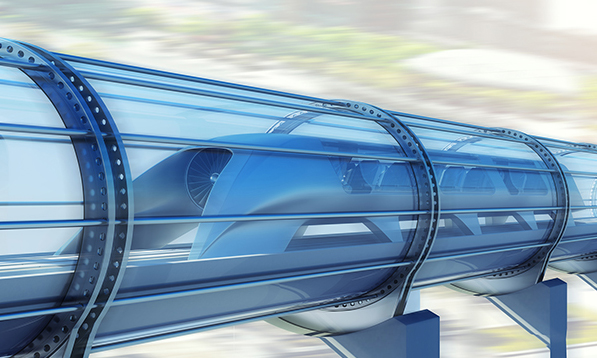The future of hyperloop in the UK: cutting through the hype
- Like
- Digg
- Del
- Tumblr
- VKontakte
- Buffer
- Love This
- Odnoklassniki
- Meneame
- Blogger
- Amazon
- Yahoo Mail
- Gmail
- AOL
- Newsvine
- HackerNews
- Evernote
- MySpace
- Mail.ru
- Viadeo
- Line
- Comments
- Yummly
- SMS
- Viber
- Telegram
- Subscribe
- Skype
- Facebook Messenger
- Kakao
- LiveJournal
- Yammer
- Edgar
- Fintel
- Mix
- Instapaper
- Copy Link
Posted: 15 January 2019 | Gavin Bailey - TRL, Roseline Walker - TRL | 2 comments
Gavin Bailey, Technical and Business Development Manager, and Roseline Walker, Technical Consultant Freight and Fleet, from Transport Research Laboratory (TRL) investigate the likelihood of hyperloop being successfully integrated into the UK’s existing transport network.


TRL, the Transport Research Laboratory, has completed an independent analysis into hyperloop to determine its potential, and whether it can truly become a reality as a new mode of transport.
Since Elon Musk envisaged the concept back in 2013, hyperloop technology has been developing at an increasing pace. TRL’s research has examined the validity of commercial claims to understand the key strengths and weaknesses of hyperloop, potential applications and the wider implications for society.
Hyperloop has been ambitiously adopted by several companies such as Virgin Hyperloop One and Hyperloop Transportation Technologies (HyperloopTT). TRL’s report recognises that although hyperloop offers several benefits in relation to speed and energy, there are still significant barriers that need to be addressed long before it could become a reality – primarily that the technology remains unproven.
The truth of the matter is that hyperloop for the UK could be at least 20 years away. However, there are a number of actions that can be undertaken now, such as establishing a supply chain for hyperloop and incorporating the key skills and knowledge that this country has to offer in an initial research and development phase. This should be the first step towards a comprehensive understanding of what the system will look like.
From a TRL perspective, there are a variety of areas that require an assessment and review in order to build the safety case for this new mode of transport, including a full and detailed appraisal of the system, highlighting the risks and likely implications to passengers during operation. We will need to analyse every area including design process and engineering decisions, quality-control processes, cyber-security, risks of terrorism and operational/ maintenance procedures. Once all of this is completed, and the case for hyperloop agreed, the next step will be to develop a full-scale trial.
For hyperloop to be publicly acceptable, its safety must be demonstrated effectively. The nature of the hyperloop system presents unique safety challenges and the severity of any incident has the potential to be extremely high. The only way for these challenges to be overcome is through real-world trials on test tracks which are currently under development.
A robust safety case will form a key part of managing the risk process, but it is not enough on its own. Organisations operating hyperloop systems will need to work within a proven framework to provide the necessary degree of assurance required. The approach to safety governance for hyperloop should be similar to other technically-complex, high-hazard industries such as rail, aviation and nuclear power.
We’re involved in several projects which require safety assurances for advanced transport technologies, for example: in collaboration with Continuum Industries on the human factors and safety requirements for the hyperloop concept, as well as GATEway for their connected and autonomous vehicles (CAV) in urban environments project.
In TRL’s view, the case for hyperloop is strongest in terms of freight transport applications. Travelling at the contemplated speeds (c. 760mph), the concerns around the impact on humans are removed, which means that the pods can travel through tighter corners with fewer repercussions on the cargo. That doesn’t negate the safety case for this system, but it does take away all the human factors related to the transportation of people.
A current project being undertaken with Magway is starting to look into this concept. Delivering parcels between distribution and consolidation centres via underground pipelines, the intention is to insert multiple destinations along the journey, therefore increasing the potential of its uptake for freight as it becomes possible to deliver cargo to multiple locations across the country.
Wide scale adoption of this method of freight transportation could reduce congestion on road and rail systems, with organisations looking to the increased speed and efficiency of hyperloop to decrease the time to destination.
TRL believes that at this stage, moving freight via hyperloop, has far greater potential than passenger transport. However, until the necessary trials are complete and more research is undertaken into its overall viability, there are too many unknowns to understand whether hyperloop will become a feasible mode of transport.
Biographies




Related topics
Fleet Management & Maintenance, Vehicle & Passenger Safety
Related cities
United Kingdom
Related organisations
Transport Research Laboratory (TRL)
Related people
Gavin Bailey, Roseline Walker








isn’t the supply chains r&d down to the people who design and build the thing? Fast rail networks are looking like old tech right now , major infrastructure projects need to be future proof , fast rail networks should’ve been implemented in the 70s . Not a n the 21st century , we need 21st century tech ,green credentials and low environmental impact ,along with affordable pricing and installation costs ,all this can be achieved with Tesla’s system, if this nation is to keep with the times , rail isn’t the way .
Talking about the Hyperloop System for the future. Richard Branson said. From London to Edinburgh would cut the journey to less than a Hour. But would it Expand to Aberdeen to 1 Hour and 30 minutes? if all going well. Hopefully it will Expand to Newcastle upon Tyne and Sunderland as well. But how much would the fare cost. If they continue to Expand. And as i live in Enfield. Will it take me to places like Clacton on Sea, Southend on Sea, Henley on Thames, Cardiff, Hastings, Eastbourne, Brighton, Great Yarmouth, Blackpool, Oxford, Cambridge, Liverpool, Manchester and Cornwall etc?